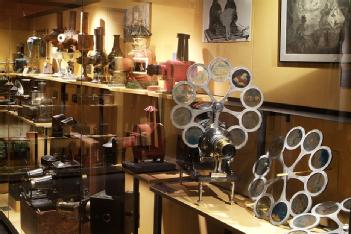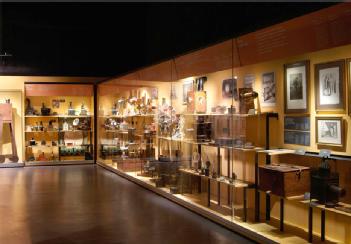
  |
Museo del Cine-Colección Tomàs Mallol |
17001 Girona, Spain (Katalonien) |
|
| Address |
C/ Sèquia, 1
|
| Floor area | 1 500 m² / 16 146 ft² |
Movie recording and playback
- Mechanical Music Instruments
- TV and image recording
- Photo cameras and slide projectors
- Toys
- Media
- Camera Obscura
- Gramophone (no electrical sound transmission)
|
Opening times
|
September to June: Tuesday to Saturday: 10am - 6pm Sunday and Mondays that are public holidays: 10am - 2pm De septiembre a junio: De martes a sábado de 10 a 18 h
Domingo y lunes festivos de 10 a 14 h |
||||||||
|
Status from 01/2021
|
General: 6 €; reduced: 3 € General: 6 €; reducida: 3 € |
||||||||
| Contact |
|
||||||||
| Homepage | museudelcinema.girona.cat/cat/index.php | ||||||||
| Location / Directions |
Girona is a city in northern Catalonia, Spain, at the confluence of the Ter, Onyar, Galligants, and Güell rivers. |
| Description | Wikipedia: The visit through the 1500 square metres of exhibition space begins on the lower floor, with an audiovisual display that works as a prologue. The first section, on the third floor, is dedicated to Chinese shadow theatre puppets, an art with ancestral origins. Next, in the interior of a room without light the camera obscura allows us to see the reflection of the exterior images of the world, and understand why this phenomenon is the basis on which the technique of photography and cinema is founded. The next section is dedicated to mirrors, which allowed us to capture ephemeral images of the world generating optical games that drew the attention of science and the esoteric interests of the past. Following on this, we observe one of the essential sections of the museum, dedicated to the magic lantern. Two hundred years before the invention of cinema, the magic lantern converted the projection of images into a form of mass entertainment for the first time, providing information and serving as an educational tool. In the seventeenth and eighteenth centuries, instruments were built to enable the human hand to fix the images captured by the camera obscura. The exhibition shows what these tools were, the resulting images and how they could be observed by means of peep show or the Mondo Nuovo, a travelling show that introduced viewers to far-off cities and landscapes without leaving their homes. Now on the second floor, the exhibition continues with instruments based on the principle of the persistence of vision that began to generate the illusion of moving Images, even though they were simply drawings that were animated through repetitive movements After this, we enter into the section dedicated to the definitive path towards cinema as we know it, when in the twenty years preceding its invention scientists the world over began an increasingly accelerated race towards the discovery of the projection of photographic images in movement. Finally, the visitor comes to a space that refers to the historical moment itself, on December 28, 1895. On that day, in the Salon Indien, found in the cellar of the Grand Café in Paris, the Lumière brothers offe¬red the first paid public projection with an instrument of their own invention the cinematograph. On the first floor we find two examples of how the magic of cinema pertains to amateurs and children as well. Instruments related to amateur film from the early period and to children's cinema, especially with the popular Cine NIC, are shown in these final metres of the permanent exhibition. The exhibition concept is not limited to merely setting out the most important parts of the Tomàs Mallol Collection (with nearly 1500 objects on display). It also seeks to work as an Interactive display that is friendly and educational. |
| Description (other) |
Wikipedia: l discurs de l'exposició permanent de la Col·lecció Tomàs Mallol se centra en l'espectador. És a dir, l'espectador de tots els temps que ha gaudit i ha quedat meravellat per les imatges. Des de les ombres xineses, sempre hi ha hagut en la nostra societat espectacles visuals que han fascinat a homes i dones a través de les imatges. La llanterna màgica, el Mondo Nuovo, el Panorama, les ombres xineses, el kinetoscopi d'Edison, el Teatre Òptic, etc. són alguns d'aquests “pares” del cinema com a espectacle. Però en aquesta exposició també es pot constatar l'evolució de la tècnica de la representació de la realitat en imatges. Així, les càmeres obscures, la fotografia, els aparells per a donar moviment a les imatges (fenaquistoscopis, zoòtrops…), les cronofotografies (fotografies d'un cos en moviment), etc. són diferents estadis en l'evolució tècnica de la imatge, que tenen el seu punt culminant en el cinematògraf inventat el 1895 pels germans Lumière. Però la història no s'acaba aquí. El cinema és una anella més d'aquesta llarga cadena dels espectacles visuals i de la representació de la realitat en imatges i per això va seguir evolucionant: la incorporació del so, del color, dels formats, dels efectes especials, l'adveniment de la televisió, i avui dia de les noves imatges digitals i la realitat virtual que ens obren un futur que no podem ni imaginar. La tècnica de la imatge va canviant amb el pas del temps, però l'emoció de l'espectador és sempre la mateixa. Aquest és, en definitiva el discurs del Museu: explicar aquesta llarga història de la fascinació de l'home per les imatges en moviment des de les primitives ombres xineses fins als primers anys de cinema. Aquesta història està dividida en el Museu en 10 apartats més un audiovisual que serveix de pròleg de l'exposició i un epíleg que fa referència al cinema amateur i el cinema infantil. El discurs principal finalitza en els anys 1930, amb l'arribada de les primeres televisions. |
[dsp_museum_detail.cfm]
| Data Compliance | More Information |

 museudelcinema.cat
museudelcinema.cat 



